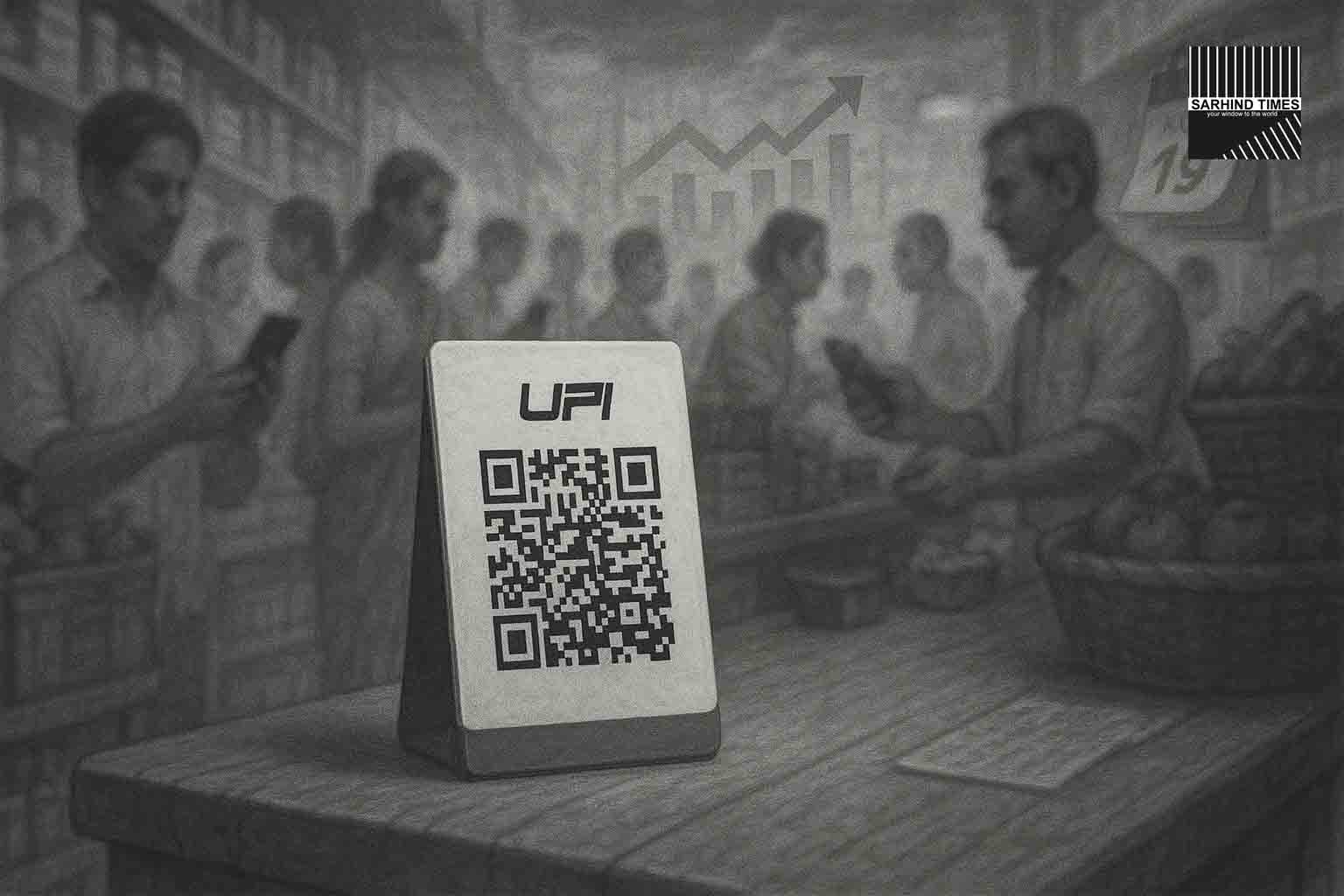By Sarhind Times Business Desk | New Delhi | October 2, 2025
Dateline: India’s real-time payments workhorse, the Unified Payments Interface (UPI), eased off its record August peak but still printed another blockbuster month in September 2025. Transaction count slipped to 19.63 billion from August’s all-time high of 20.01 billion, even as total value edged up to ₹24.90 lakh crore—a hint that average ticket sizes increased. The Reserve Bank also reiterated there is no proposal to levy charges on UPI, keeping the rails free for users while platforms and banks continue to absorb operational costs.
A rule change also kicked in this week: NPCI’s discontinuation of P2P “Collect Request” on UPI from October 1–2 (as specified across advisories) to reduce fraud vectors and simplify the product set, with banks and apps instructed to block such flows.
The Print: What the Numbers Say
According to NPCI-based reporting, UPI processed 19.63 billion transactions in September, down roughly 1.9% month-on-month from August’s 20.01 billion, while value inched up to ₹24.90 lakh crore from ₹24.85 lakh crore. Analysts flag two straightforward explanations: (1) seasonality and calendar effects (September had fewer days than August), and (2) a mix shift to higher-value merchant and bill payments, including quarter-end tax flows and early festive pre-buys.
Daily operating intensity stayed formidable. Coverage pegged average daily volumes near ~654 million transactions, with average daily value ~₹83,000 crore, each a notch higher than August. These prints underscore why UPI now functions as financial plumbing: always-on, elastic to spikes, and increasingly embedded deep in retail and enterprise flows.
The Signal: Fewer Payments, Bigger Tickets
The divergence—slightly lower counts, slightly higher value—means larger average payments. Put simply, even though people and businesses executed fewer UPI transactions than the previous month, they moved more money overall.
Three drivers stand out:
- Quarter-end flows. GST and other compliance payments often bunch near month/quarter boundaries, lifting ticket sizes.
- Festive pre-buys. Autos, appliances, and electronics see deposits and down-payments in late September as consumers stage purchases for October–November.
- B2B & bill layers. More enterprise workflows (from supplier payouts to subscription stacks) keep migrating to UPI rails, raising average value per hit.
Policy Backdrop: UPI Remains Free for Users
The RBI has again clarified there is no current proposal to impose user charges on UPI. While the ecosystem bears tangible costs—fraud controls, cloud infra, compliance, dispute handling—the public-good stance on UPI remains intact “under the present policy.” The message stabilizes expectations for consumers and merchants and avoids demand friction just as festive traffic ramps.
Why it matters: Pricing uncertainty can depress transaction growth and deter marginal users. A clean “no charges” signal preserves UPI’s network effects—critical when 650M+ daily payments depend on habit and trust.
Product Hygiene: End of P2P “Collect Request”
NPCI’s circular required all banks, PSPs, and UPI apps to discontinue P2P Collect Request beginning October 1 (with some notices referencing October 2 as the cutover). The instruction: no collect transaction should be initiated, routed, or processed beyond the date. Rationale: the feature had become a phishing and social-engineering vector, where bad actors spammed victims with pop-up requests. With Scan-to-Pay and Intent/Deep Links dominating legitimate flows, phasing out Collect Request tightens attack surface without impairing routine usage.
What users will notice:
- You’ll still receive and make payments normally via QR, intents, UPI IDs, and contact lists.
- You won’t receive “pay request” pop-ups from individuals anymore.
- Merchant requests (P2M) are unaffected and continue as before.
Rails Check: Other Channels Also Softened
It wasn’t just UPI; IMPS, FASTag (NETC), and AePS also showed month-on-month moderation in September, pointing to broader calendar effects and post-monsoon consumption timing. For payments ops teams, that’s a useful breather before October’s surge.
Anatomy of a Super-Rail
Five features keep UPI’s flywheel spinning:
- Zero-price to users. A deliberate design and policy stance—critical for mass adoption and habit formation.
- Open, interoperable, bank-grade. A common scheme across banks, apps, and switches (NPCI) ensures ubiquity.
- Composability. Credit-on-UPI, UPI Lite (for small tickets), and Tap-and-Pay widen contexts and use cases.
- Merchant ubiquity. From street vendors to e-commerce checkouts, UPI is everywhere.
- Trust + recourse. In-app dashboards, refunds, and escalating fraud controls reinforce confidence.
The Festive Arc: What October Could Look Like
October–November is payments peak season in India. Expect:
- Daily volumes to push back toward August highs as Dussehra–Diwali sales mature.
- Ticket sizes to stay elevated with consumer durables, autos, travel, and fashion in play.
- Merchant QR saturation to deepen, including tier-2/3 localities with seasonal bazaars.
- Credit-on-UPI pilots to show up more visibly at checkout, blending convenience with affordability.
Fraud & Safety: The Constant Tug-of-War
Ending P2P Collect removes a noisy fraud vector, but adversaries pivot quickly. The ecosystem’s next moves are already visible:
- Up-front risk scoring of payees and flows using behavioral signals.
- AI-driven anomaly detection shared across banks and PSPs for faster interdiction.
- Contextual prompts (“Are you paying a stranger?”) in apps when risk rises.
- Tighter PSP onboarding and re-KYC cycles.
Regulators have signaled that consumer protection and fraud containment will stay front-and-center through the festive quarter.
Merchant Lens: MDR, Settlement, and “Works-Out-of-the-Box”
For small merchants, UPI’s zero-MDR regime remains a boon, though industry groups periodically raise sustainability concerns on acquiring economics. For now, scale is the answer: ubiquitous QR reduces cash-handling overheads, shrinks lost-sale risk, and brings structured data into day-to-day business.
What matters most to merchants in Oct–Nov:
- Settlement reliability during peak hours.
- Automatic reconciliations with inventory and billing.
- Refund SLAs that match customer expectations.
- Tap-and-Pay and Lite for queues under pressure.
Bank/PSP Ops: Throughput, Resilience, and NOC Nights
Running UPI at 650M+ transactions/day is a systems engineering feat. The boring—but vital—upgrades are where peak-season wins are made:
- Horizontal scaling of API clusters and switch interfaces.
- Rate-limit harmonization so no single handover becomes a chokepoint.
- Tokenization and real-time telemetry for fraud and SRT (service restore time).
- Dry-runs timed to shopping festivals and salary days.
ETBFSI’s print on 654M daily txns is the pressure gauge ops heads watch; keeping drop rates and latency tame at that scale is the real KPI.
Macro Read-Through: Consumption, Capex, and the 2025–26 Cycle
- Consumption: The September value uptick suggests healthy household and SME spending, even with m/m count dip. Expect a stronger read in October’s numbers.
- Capex: UPI’s role in B2B micro-flows (supplier payments, SaaS, utilities) keeps deepening; each layer de-frictions commerce.
- Financial inclusion: With AePS and UPI Lite, the low-ticket frontier is expanding, crucial for cash-heavy cohorts.
Internationalization: Beyond Borders (and Why It’s Slow by Design)
UPI’s linkages with partner countries (acceptance at POS/ATMs, wallet interop, corridor pilots) continue to widen, though gradually—each corridor must align on KYC, AML, data localization, and settlement risk. The point isn’t speed; it’s predictability and risk parity. Expect tourism corridors and diaspora remittances to lead, with merchant acquiring following once regulators on both sides are comfortable.
FAQ: What Users and Merchants Asked Us This Week
Q1. Will I have to pay a fee for UPI in the future?
A. The RBI has reiterated there is no proposal under consideration to levy user charges on UPI under present policy. If that changes, it will be clearly communicated.
Q2. Why did my app remove “Collect Request” from a friend?
A. NPCI has discontinued P2P Collect from Oct 1–2. You can still pay via QR, contact, UPI ID, or intent links.
Q3. Are merchant “pay requests” impacted?
A. No. Merchant request flows (P2M) continue as before.
Q4. If volumes fell in September, is UPI slowing?
A. No—calendar and mix explain most of the m/m dip; value rose, and daily averages stayed high (~654M). Watch October.
Q5. What’s the bottom line for festive season?
A. Expect record-challenging weeks—especially around salary credit days, Dussehra, and Diwali weekend.
The Chartbook (Narrated)
While we’re not embedding graphs here, the datapoints worth pinning on your newsroom board are:
- August 2025: 20.01 bn txns; ₹24.85 lakh cr value (record count).
- September 2025: 19.63 bn txns; ₹24.90 lakh cr value (higher value, lower count).
- Daily averages (Sep): ~654M txns; ₹82,991 cr avg daily value.
- Rule change: P2P Collect discontinued from Oct 1–2 (per circular/advisories).
- Policy: No UPI user charges proposed at present.
Editorial Note: What to Watch Next
- October numbers: pay-day + Dussehra → near-record daily peaks plausible.
- Credit on UPI: expect more banks to surface it inline at checkout.
- UPI Lite and Tap-and-Pay: queue-buster for metros and malls.
- Fraud metrics: post-Collect retirement, phishing patterns will mutate; apps should nudge smarter.
- Merchant resilience: monitor refund speed, failed-payment rate, and retries during peak hours.
Lede Re-cap (for Page-One box)
- UPI September: 19.63 bn txns; ₹24.90 lakh cr value.
- M/M: Count ↓ (vs Aug 20.01 bn), value ↑ (vs Aug ₹24.85 lakh cr).
- Policy: No user charges proposed on UPI at present.
- Rule change: P2P Collect discontinued from Oct 1–2.
#UPI #Fintech #NPCI #DigitalPayments #RBI #IndiaTech #Banking #CashlessIndia






















+ There are no comments
Add yours